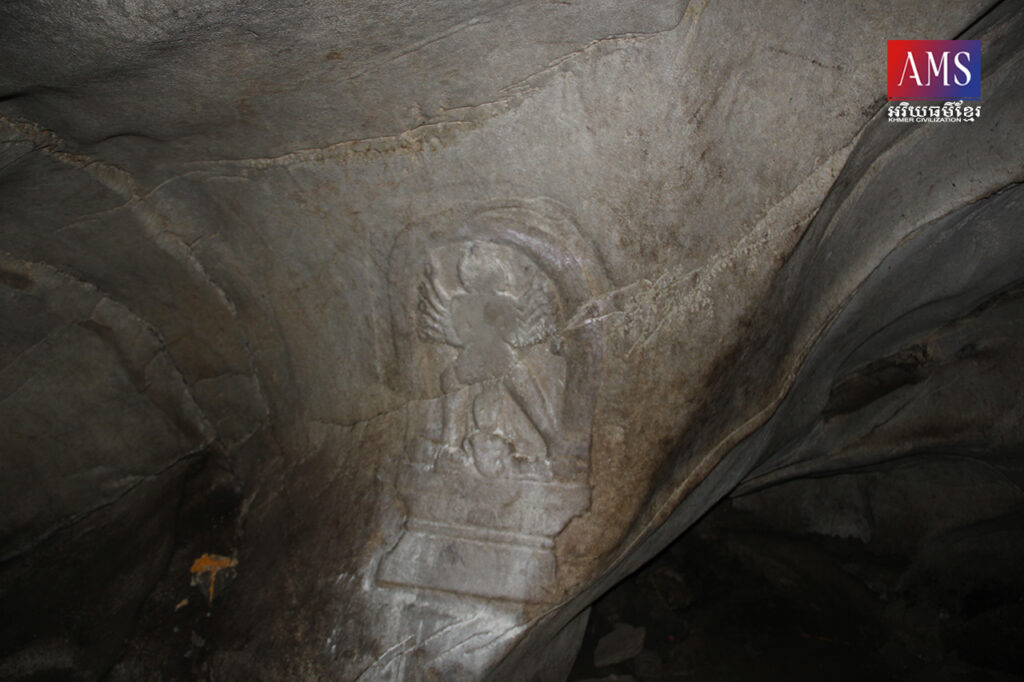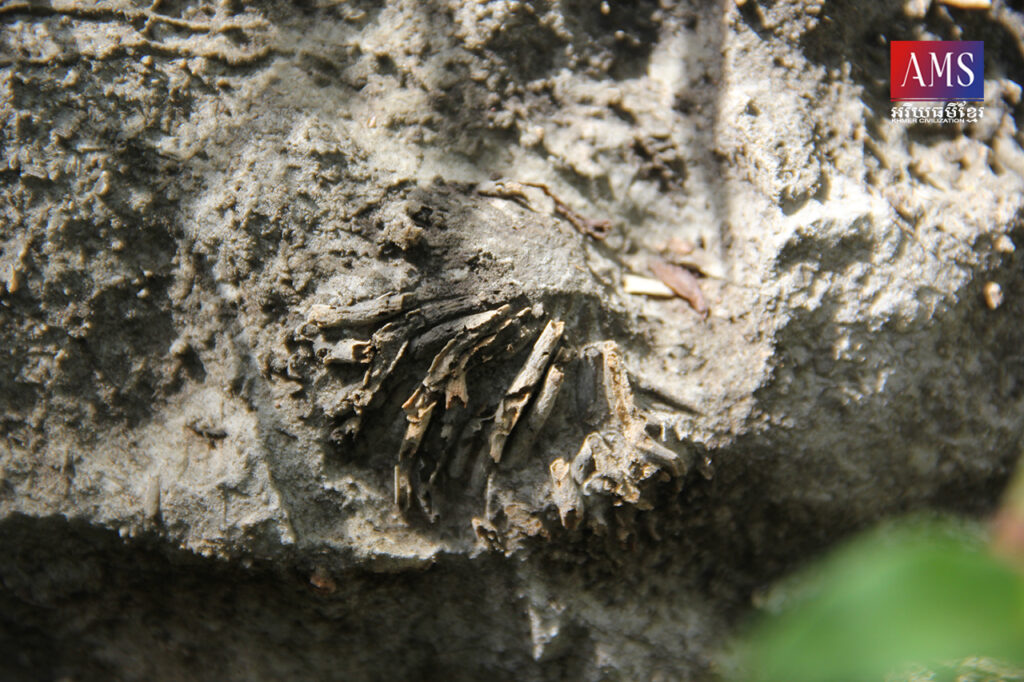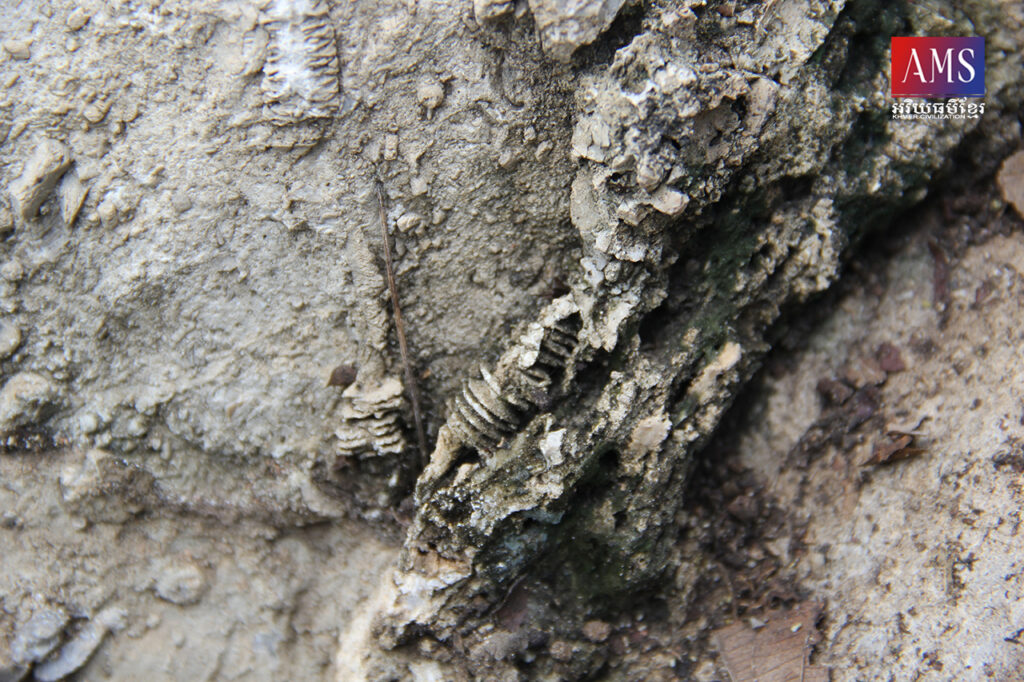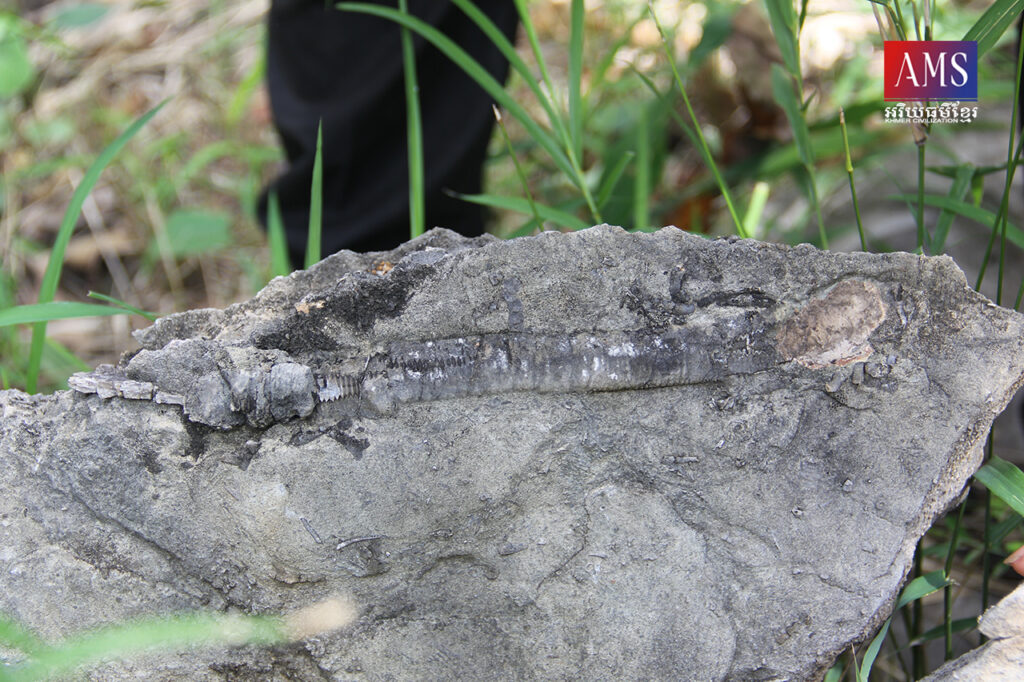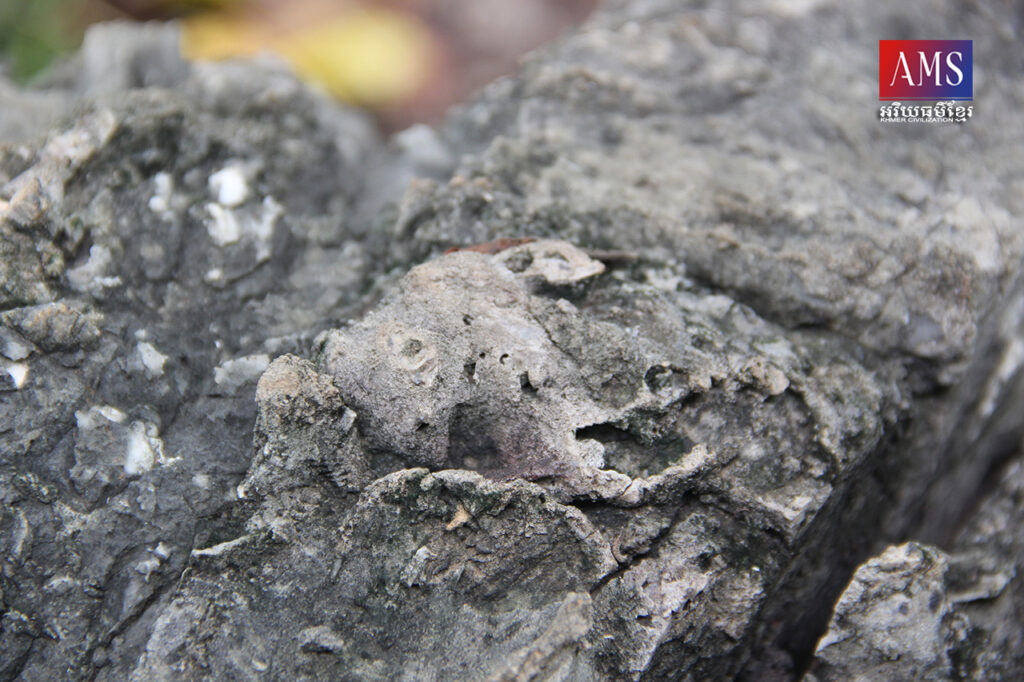ភ្នំព្រះភ្នំវែងជាស្ថានីយ៍ផូស៊ីលសត្វសមុទ្របុរាណមួយកន្លែង មានទីតាំងស្ថិតនៅឃុំថ្មពួក ស្រុកថ្មពួក ខេត្តបន្ទាយមានជ័យ និងមួយផ្នែកតូចជាប់និងខេត្តឧត្តរមានជ័យក្នុងភូមិសាស្ត្រស្រុកបន្ទាយអំពិល។ ដើម្បីទៅកាន់ភ្នំនេះ គឺអាចធ្វើដំណើរពីទីរួមខេត្តបន្ទាយមានជ័យ ទៅកាន់ខេត្តឧត្តរមានជ័យតាមផ្លូវលេខ៥៦។ មកដល់ទីរួមស្រុកថ្មពួក ត្រូវបន្តដំណើរប្រមាណ២ទៅ៣គីឡូម៉ែត្រទៀត បន្ទាប់មកនឹងប្រទះផ្លូវគ្រួសក្រហមនៅខាងស្តាំដៃ រួចបត់ចូលត្រង់ប្រមាណ១០គីឡូម៉ែត្រនឹងឃើញភ្នំព្រះភ្នំវែងនៅខាងស្តាំដៃ។
នៅកំឡុងឆ្នាំ២០២០ក្រុមការងារសិក្សាផូស៊ីលនៃនាយកដ្ឋានតំបន់បេតិកភណ្ឌ អគ្គសហគមន៍មូលដ្ឋាន នៃក្រសួងបរិស្ថាន បានចុះទៅសិក្សាផូស៊ីលជាបឋមនៅតំបន់នោះ។ ក្រោយមកភ្នំព្រះភ្នំវែងបានដាក់ចូលជាតំបន់បេតិកភណ្ឌធម្មជាតិ ដោយអនុក្រឹត្យលេខ៦៩អនក្រ.បក ចុះថ្ងៃទី២៥ឧសភា ឆ្នាំ២០២០ ដោយមានក្រឡាផ្ទៃ១៥០០ហិចតា។
ភ្នំព្រះភ្នំវែងជាភ្នំថ្មកំបោរដែលបានកំណត់អាយុកាលក្នុងស័កទី១ Paleozoic សម័យ Permian (២៥១-២៩៩លានឆ្នាំ)។ភ្នំនេះមានរូងភ្នំជាច្រើន និងមានបុរាណស្ថានដែលជាទីគោរពបូជាបែបព្រះពុទ្ធសាសនាមហាយាន ដោយមានរូបចម្លាក់ទេពដៃច្រើនដែលមានទម្រង់ប្រហាក់ប្រហែលនឹងចម្លាក់នៅប្រាសាទបន្ទាយឆ្មារ គ្រាន់តែមានទំហំតូច ហើយឆ្លាក់ក្នុងរូងភ្នំ។ យើងក៏បានពិនិត្យស្លាកស្នាមសត្វសមុទ្របុរាណក្នុងរូងភ្នំមួយចំនួនផងដែរ។
ភ្នំនេះមានអតីតកាលជាសមុទ្រ ហើយកើតឡើងដោយកំណកកំបោរ។ ថ្មកំបោរជាប្រភេទថ្មដែលកើតពីកំណកនៃជីវៈចម្រុះមួយចំនួនប្រមូលផ្តុំគ្នា ដូចជាសំបកគ្រំ ងាវ, ផ្កាថ្ម, សារាយ, សំណល់ផ្សេងៗ និងកំទេចកំទីសរីរាង្គ។ វាក៏អាចបង្កើតបានដោយដំណើរការនៃកំណកគីមី ដូចជាទឹកភ្លៀងនៃកាបូនកាល់ស្យូមពីទឹកបឹង ឬទឹកសមុទ្រ។ ថ្មទាំងនេះកើតនៅក្នុងតំបន់ទឹកសមុទ្រស្ងប់ ទឹករាក់ ថ្លា និងមានថ្មប៉ប្រះទឹក។ ដោយសារកំណកកំបោរដែលបានពីសារធាតុកំបោរ នៃពពួកសត្វសមុទ្រ ធ្វើឱ្យភ្នំព្រះភ្នំវែងបន្សល់នូវភស្តុតាងមួយចំនួន ដែលអាចបញ្ជាក់ថាទីតាំងនេះពិតជាសមុទ្រកាលពីអតីត។ ភស្តុតាងនោះមានដូចជា៖
១. ប្រភេទផ្កាថ្មស្នែងរកឃើញនៅស្រទាប់ថ្មមួយនៅជើងភ្នំ ក្បែរស្នាក់ការបរិស្ថាន។ ផ្កាថ្មប្រភេទនេះក៏ធ្លាប់រកឃើញនៅស្ថានីយ៍ផូស៊ីលភ្នំបាក់ ដែលស្ថិតនៅក្នុងជម្រៅជ្រៅ។ ប្រភេទផ្កាថ្មស្នែងស្ថិតនៅក្នុង Phylum Cnidaria, Class Anthozoa, Rugosa Corals។ ពពួកនេះមានប្រវត្តិរីកចំរើននៅក្នុងស័កទី១ Paleozoic ដែលស្ថិតនៅក្នុងចន្លោះពី ៤៥០លានឆ្នាំ បន្តមកដល់ចុងសម័យ Permian មានអាយុកាល២៥១លានឆ្នាំ។ ប្រភេទនេះមាននៅសល់តិចតួចក្នុងពេលបច្ចុប្បន្ន។
២. ផ្កាថ្មមួយប្រភេទទៀតឈ្មោះ Aulopora Sp. ស្ថិតក្នុងអំបូរ Phylum Cnidaria, Class Anthozoa, Sub Class Tabulata ក៏ត្រូវបានរកឃើញនៅក្បែរគ្នាផងដែរ។
៣.ផ្កាថ្មមួយប្រភេទទៀត ក៏ស្ថិតនៅក្នុងអំបូរ Aulopora Sp. ដូចដែរ ប៉ុន្តែមានឈ្មោះខុសគ្នា។ វាស្ថិតក្នុងអំបូរ Phylum Cnidaria, Class Anthozoa, Sub Class Tabulata, Family Syringopodae, Genus Syringopora។ ផ្កាថ្មនេះ បានរកឃើញនៅក្បែរនោះផងដែរ។ ពពួកនេះក៏ធ្លាប់ប្រទះនៅស្ថានីយផូស៊ីលភ្នំបន្ទាយនាង និងភ្នំកងវ៉ា។
៤. ពពួកគ្រីណូអ៊ីត ជាប្រភេទ២ផ្សេងគ្នា។ ស្ថិតក្នុងអំបូរ Phylum Echinodermata, Class Crinoidea។ តាមរយៈឯកសារបានបញ្ជាក់ថា ពពួកគ្រីណូអ៊ីតមានជាង៦០០០ប្រភេទ និងបន្តរស់នៅក្នុងពេលបច្ចុប្បន្នជាង៦០០ប្រភេទ ហើយពពួកនេះក៏បន្តរស់នៅក្នុងប្រទេសកម្ពុជានាពេលបច្ចុប្បន្ននេះដែរ។ ពួកវាមានមានលក្ខណៈប្រហាក់ប្រហែលនឹងពពួកផ្កាយសមុទ្រ។
៥. ពពួក Bryozoa មានរូបរៀងដូចសំណាញ់ ស្ថិតក្នុងអំបូរ Phylum Bryozoa។ ក្រុមនេះមានអាយុកាលចាប់ពី៤៨០លានឆ្នាំ រហូតដល់ពេលបច្ចុប្បន្ន។ ពពួកនេះក៏មាននៅស្ថានីយផូស៊ីលមួយចំនួន ក្នុងខេត្តបន្ទាយមានជ័យផងដែរ។
៦- ពពួក Spongy មានលក្ខណៈដូចជាអេប៉ុងទន់ៗ ដែលស្ថិតនៅក្នុង Phylum Porifera, Class Demospongiae។ ពពួកនេះមាននៅស្ថានីយ៍ផូស៊ីលមួយចំនួនក្នុងខេត្តបន្ទាយមានជ័យ។ បច្ចុប្បន្ន សត្វប្រភេទនេះបន្តរស់នៅឡើយ។
៧. ពពួកខ្យង ពពួកនេះប្រទះច្រើននៅតាមស្ថានីយផូស៊ីលមួយចំនួនដូចជា ភ្នំកងវ៉ា ភ្នំបាក់ ភ្នំដូងព្រះ។
៨. ពពួក Brachiopod ពពួកនេះនៅស័កទី១ មានច្រើន ហើយក៏មាននៅស្ថានីយផូស៊ីលជាច្រើន។
រួមសេចក្តីមក ភ្នំព្រះភ្នំវែងជាទីតាំងផូស៊ីលសត្វសមុទ្រ ដែលមានអាយុកាលក្នុងស័កទី១ Paleozoic ក្នុងសម័យ Permian (២៥១-២៩៩លានឆ្នាំ)។ ចំនុចទាំងឡាយដែលបានបង្ហាញខាងលើ គឺជាផ្នែកមួយនៃពត៌មានបឋម ដែលបានរកឃើញក្នុងការសិក្សាស្រាវជ្រាវអំពីផូស៊ីលនៅកម្ពុជា។ ភ្នំនេះគួរជាទីតាំងសម្រាប់ការអភិរក្សផូស៊ីលសត្វសម័យបុរាណ និងការសិក្សាស្រាវជ្រាវ។
—————————————
Fossil at Preah Phnom Veng
Phnom Preah Phnom Veng is a sea fossil site. It locates in Thmopouk commune, Thmopouk district, Banteay Meanchey province. A small part of the site closes to Banteay Ampil district, Oddor Meanchey province. Along the way from Banteay Meanchey to Oddor Meanchey through road number 56. From Thmor Pouk about two to three kilometers turn right to a gravel road, then continue on this road about ten kilometers to the mountain on the right-hand side. The site was investigated by the officers of the Ministry of Environment in 2020. On 25 May 2020, 1500 hectares’ area of the site was listed as the national heritage of Cambodia.
Phnom Preah Phnom Veng is a limestone mountain that was listed in the Paleozoic of Permian (251-299 million years). It has multiple caves, and also ancient sites of Mahayana Buddhism. There is a deity with many arms similar to the Avalokitesvara at Banteay Chhmar temple.
The area of this mountain was the sea. The accumulation of the minerals deposits and chemical reaction created limestone. Remarkably, this type of stone occurs in a stable area, low level and clear water, and the stones that arise close to water level. According to minerals calcite, and fossils, Phnom Preah Phnom Veng was a sea.
Those fossils are:
1. Phkar Thmor Sneng (Sea flower with horn shape) found in the layer of a stone at the foot of the mountain. This fossil was found in the Phnom Bak site. It is one of the species in Phylum Cridaria, Class Anthozoa, Rugosa Corals. This species appeared a lot in the Paleozoic period, 450 million years to Permian, 251 million years. However, the population is low in the present.
2. Aulopora Sp. It is in Phylum Cridaria, Class Anthozoa, Sub Class Tabulata. It found close to Phkar Thmor Sneng.
3. Another fossil is also listed in Phylum Cridaria, Class Anthozoa, Sub Class Tabulata, Family Syringopodae, Genus Syringopora. However, it has a different name. This fossil was found nearby above fossils.
4. Crinoid, listed in Phylum Echinodermata, Class Crinoidea. This type of species has about 6000 types, but it remains just about 600 types in the present. Presently, the Crinoid also exist in the Cambodian sea. It is similar to starfish.
5. Bryizoa has a net shape. It is in Phylum Bryozoa, 480 million years to the present. They are found at Banteay Meanchey.
6. Spongy is soft as a sponge. It is in Phylum Porifera, Class Demospongiae, and found in Banteay Meanchey. It still survives in the present.
7. Snail, mostly found Kangva, Bak and Dong Preah mountain.
8. Brachiopod, found in various sites.
In conclusion, Phnom Preah Phnom Veng is a sea fossil mountain dated from the Paleozoic of Permian (251-299 million years). The above information is a part of a survey and study of fossils in Cambodia. It is an important site to preserve fossils and to study.
អត្ថបទដើម៖ លោក លឹម វណ្ណច័ន្ទ



